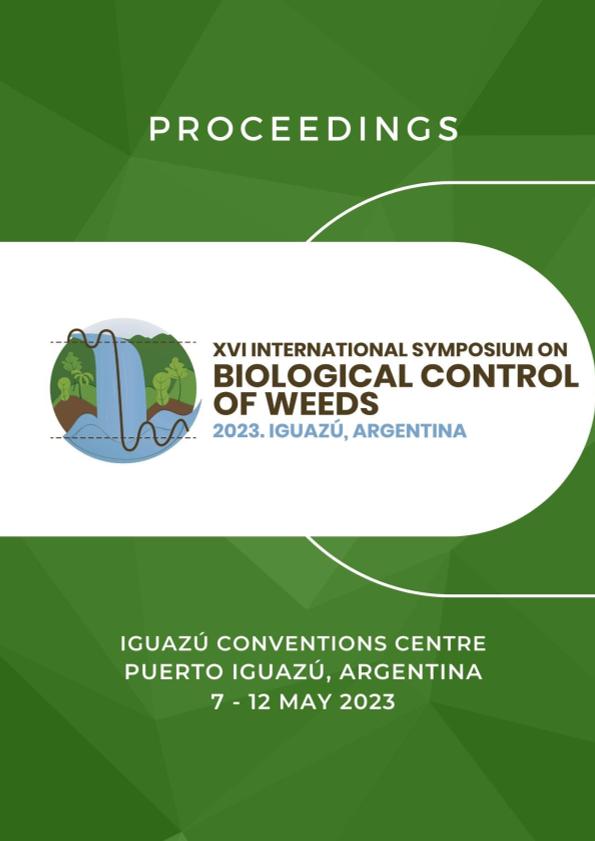Mostrar el registro sencillo del ítem
dc.contributor.author
Anderson, Freda Elizabeth

dc.contributor.author
Cabrera Walsh, Guillermo José

dc.date.available
2024-04-22T11:23:13Z
dc.date.issued
2023
dc.identifier.citation
Biological control of weeds in Argentina. Present status and hope for the future; XVI International Symposium on Biological Control of Weeds; Puerto Iguazú; Argentina; 2023; 94-94
dc.identifier.isbn
978-631-90256-0-6
dc.identifier.uri
http://hdl.handle.net/11336/233669
dc.description.abstract
Argentina hosted pioneering classical weed biological control projects that were carried out by state institutions between the 1970s and 1990s, at a time when the practice was quite young in South America. A few releases of exotic agents against thistles and skeleton weed were carried out during those years, resulting in the successful establishment of most of them, but with little effectiveness in the control of the population densities of their target weeds, and poor post liberation studies. Despite the early development of these initiatives, the discipline did not prosper. Meager financial support and a prevailing tendency towards the use of chemical herbicides as the main tool in weed control, soon ended the initial interest in these more environmentally friendly enterprises. Notwithstanding, Argentina continued, and continues, to provide biological control agents for the control of weeds in many other parts of the world. Although public concern about invasives and chemical-dependent agricultural practices has increased over time, it has not led to a greater acceptance of classical biological control of weeds. There appears to be a general unawareness of the potential of this practice amongst policy makers, and the public in general, whose perception is more oriented towards its potential risks than to the benefits derived from it. No regulations regarding declaringweeds as targets for classical biological control are in force in Argentina. Despite this, a biological control project against invasive Tamarix spp., proposed and carried forth by the authors’ laboratories was recently funded by the Argentine Ministry of Science and Technology (MinCyT), indicating that the situation may be changing, and there could be some hope for the relaunch of this practice. In addition, the possibility of exploiting resident fungal pathogens as bioherbicides, or natural enemies as part of integrated weed management programmes, is currently being explored for several significant weeds (Sorghum halepense; Convolvulus arvensis, Amaranthus spp., Conyza bonariensis, Dipsacus fullonum). These projects are (or were recently) funded by different public institutions such as the National Agricultural Technology Institute (INTA), Universidad Nacional del Sur (UNS), and the MinCyT. Manipulating natural enemies that are already present in the environment is generally perceived as less risky than importing exotic ones, and may help increase the acceptance of this control strategy in the near future. Prospects are brighter today than a few years ago. We still need to work hard on publicising the benefits of weed biocontrol to gain more support.
dc.format
application/pdf
dc.language.iso
eng
dc.publisher
International Symposium on biological control of weeds
dc.rights
info:eu-repo/semantics/openAccess
dc.rights.uri
https://creativecommons.org/licenses/by-nc-sa/2.5/ar/
dc.subject
BIOLOGICAL CONTROL WEEDS
dc.subject
ARGENTINA
dc.subject.classification
Otras Ciencias Biológicas

dc.subject.classification
Ciencias Biológicas

dc.subject.classification
CIENCIAS NATURALES Y EXACTAS

dc.title
Biological control of weeds in Argentina. Present status and hope for the future
dc.type
info:eu-repo/semantics/publishedVersion
dc.type
info:eu-repo/semantics/conferenceObject
dc.type
info:ar-repo/semantics/documento de conferencia
dc.date.updated
2024-04-08T14:14:07Z
dc.journal.pagination
94-94
dc.journal.pais
Argentina

dc.journal.ciudad
Hurlingham
dc.description.fil
Fil: Anderson, Freda Elizabeth. Consejo Nacional de Investigaciones Científicas y Técnicas. Centro Científico Tecnológico Conicet - Bahía Blanca. Centro de Recursos Naturales Renovables de la Zona Semiárida. Universidad Nacional del Sur. Centro de Recursos Naturales Renovables de la Zona Semiárida; Argentina
dc.description.fil
Fil: Cabrera Walsh, Guillermo José. Fundación para el Estudio de Especies Invasivas; Argentina
dc.relation.alternativeid
info:eu-repo/semantics/altIdentifier/url/https://www.iobc-global.org/global_sg_Classical_Weed_BC.html
dc.conicet.rol
Autor

dc.conicet.rol
Autor

dc.coverage
Internacional
dc.type.subtype
Simposio
dc.description.nombreEvento
XVI International Symposium on Biological Control of Weeds
dc.date.evento
2023-05-07
dc.description.ciudadEvento
Puerto Iguazú
dc.description.paisEvento
Argentina

dc.type.publicacion
Book
dc.description.institucionOrganizadora
Fundación para el estudio de especies invasivas
dc.description.institucionOrganizadora
Centro de Recursos Naturales Renovables de la Zona Semiárida
dc.source.libro
Proceedings of the XVI International Symposium on biological control of weeds
dc.date.eventoHasta
2023-05-12
dc.type
Simposio
Archivos asociados
